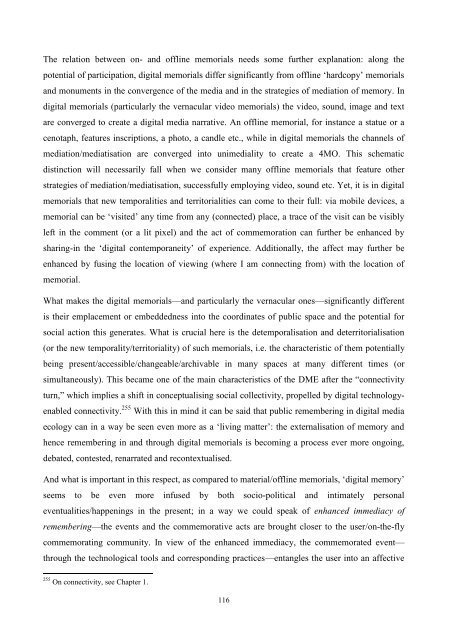UNIVERSITY OF NOVA GORICA GRADUATE SCHOOL ...
UNIVERSITY OF NOVA GORICA GRADUATE SCHOOL ...
UNIVERSITY OF NOVA GORICA GRADUATE SCHOOL ...
You also want an ePaper? Increase the reach of your titles
YUMPU automatically turns print PDFs into web optimized ePapers that Google loves.
The relation between on- and offline memorials needs some further explanation: along the<br />
potential of participation, digital memorials differ significantly from offline ‗hardcopy‘ memorials<br />
and monuments in the convergence of the media and in the strategies of mediation of memory. In<br />
digital memorials (particularly the vernacular video memorials) the video, sound, image and text<br />
are converged to create a digital media narrative. An offline memorial, for instance a statue or a<br />
cenotaph, features inscriptions, a photo, a candle etc., while in digital memorials the channels of<br />
mediation/mediatisation are converged into unimediality to create a 4MO. This schematic<br />
distinction will necessarily fall when we consider many offline memorials that feature other<br />
strategies of mediation/mediatisation, successfully employing video, sound etc. Yet, it is in digital<br />
memorials that new temporalities and territorialities can come to their full: via mobile devices, a<br />
memorial can be ‗visited‘ any time from any (connected) place, a trace of the visit can be visibly<br />
left in the comment (or a lit pixel) and the act of commemoration can further be enhanced by<br />
sharing-in the ‗digital contemporaneity‘ of experience. Additionally, the affect may further be<br />
enhanced by fusing the location of viewing (where I am connecting from) with the location of<br />
memorial.<br />
What makes the digital memorials—and particularly the vernacular ones—significantly different<br />
is their emplacement or embeddedness into the coordinates of public space and the potential for<br />
social action this generates. What is crucial here is the detemporalisation and deterritorialisation<br />
(or the new temporality/territoriality) of such memorials, i.e. the characteristic of them potentially<br />
being present/accessible/changeable/archivable in many spaces at many different times (or<br />
simultaneously). This became one of the main characteristics of the DME after the ―connectivity<br />
turn,‖ which implies a shift in conceptualising social collectivity, propelled by digital technologyenabled<br />
connectivity. 255 With this in mind it can be said that public remembering in digital media<br />
ecology can in a way be seen even more as a ‗living matter‘: the externalisation of memory and<br />
hence remembering in and through digital memorials is becoming a process ever more ongoing,<br />
debated, contested, renarrated and recontextualised.<br />
And what is important in this respect, as compared to material/offline memorials, ‗digital memory‘<br />
seems to be even more infused by both socio-political and intimately personal<br />
eventualities/happenings in the present; in a way we could speak of enhanced immediacy of<br />
remembering—the events and the commemorative acts are brought closer to the user/on-the-fly<br />
commemorating community. In view of the enhanced immediacy, the commemorated event—<br />
through the technological tools and corresponding practices—entangles the user into an affective<br />
255 On connectivity, see Chapter 1.<br />
116

















